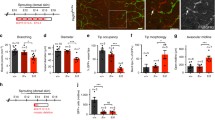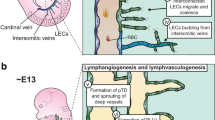Abstract
The basic biology of blood vascular endothelial cells has been well documented. However, little is known about that of lymphatic endothelial cells, despite their importance under normal and pathological conditions. The lack of a lymphatic endothelial cell line has hampered progress in this field. The objective of this study has been to establish and characterize lymphatic and venous endothelial cell lines derived from newly developed tsA58/EGFP transgenic rats harboring the temperature-sensitive simian virus 40 (SV40) large T-antigen and enhanced green fluorescent protein (EGFP). Endothelial cells were isolated from the transgenic rats by intraluminal enzymatic digestion. The cloned cell lines were named TR-LE (temperature-sensitive rat lymphatic endothelial cells from thoracic duct) and TR-BE (temperature-sensitive rat blood-vessel endothelial cells from inferior vena cava), respectively, and cultured on fibronectin-coated dishes in HuMedia-EG2 supplemented with 20% fetal bovine serum and Endothelial Mitogen at a permissive temperature, 33°C. A temperature shift to 37°C resulted in a decrease in proliferation with degradation of the large T-antigen and cleavage of poly (ADP-ribose) polymerase. TR-LE cells expressed lymphatic endothelial markers VEGFR-3 (vascular endothelial growth factor receptor), LYVE-1 (a lymphatic endothelial receptor), Prox-1 (a homeobox gene product), and podoplanin (a glomerular podocyte membrane mucoprotein), together with endothelial markers CD31, Tie-2, and VEGFR-2, whereas TR-BE cells expressed CD31, Tie-2, and VEGFR-2, but no lymphatic endothelial markers. Thus, these conditionally immortalized and EGFP-expressing lymphatic and vascular endothelial cell lines might represent an important tool for the study of endothelial cell functions in vitro.








Similar content being viewed by others
References
Achen MG, Jeltsch M, Kukk E, Makinen T, Vitali A, Wilks AF, Alitalo K, Stacker SA (1998) Vascular endothelial growth factor D (VEGF-D) is a ligand for the tyrosine kinases VEGF receptor 2 (Flk1) and VEGF receptor 3 (Flt4). Proc Natl Acad Sci USA 95:548–553
Banerji S, Ni J, Wang SX, Clasper S, Su J, Tammi R, Jones M, Jackson DG (1999) LYVE-1, a new homologue of the CD44 glycoprotein, is a lymph-specific receptor for hyaluronan. J Cell Biol 144:789–801
Breiteneder-Geleff S, Soleiman A, Kowalski H, Horvat R, Amann G, Kriehuber E, Diem K, Weninger W, Tschachler E, Alitalo K, Kerjaschki D (1999) Angiosarcomas express mixed endothelial phenotypes of blood and lymphatic capillaries: podoplanin as a specific marker for lymphatic endothelium. Am J Pathol 154:385–394
Clarijs R, Schalkwijk L, Hofmann UB, Ruiter DJ, Waal RM de (2002) Induction of vascular endothelial growth factor receptor-3 expression on tumor microvasculature as a new progression marker in human cutaneous melanoma. Cancer Res 62:7059–7065
Grant DS, Tashiro K, Segui-Real B, Yamada Y, Martin GR, Kleinman HK (1989) Two different laminin domains mediate the differentiation of human endothelial cells into capillary-like structures in vitro. Cell 58:933–943
Hakamata Y, Tahara K, Uchida H, Sakuma Y, Nakamura M, Kume A, Murakami T, Takahashi M, Takahashi R, Hirabayashi M, Ueda M, Miyoshi I, Kasai N, Kobayashi E (2001) Green fluorescent protein-transgenic rat: a tool for organ transplantation research. Biochem Biophys Res Commun 286:779–785
Hattori K, Muta M, Toi M, Iizasa H, Shinsei M, Terasaki T, Obinata M, Ueda M, Nakashima E (2001) Establishment of bone marrow-derived endothelial cell lines from ts-SV40 T-antigen gene transgenic rats. Pharm Res 18:9–15
Hosoya K, Tomi M, Ohtsuki S, Takanaga H, Ueda M, Yanai N, Obinata M, Terasaki T (2001) Conditionally immortalized retinal capillary endothelial cell lines (TR-iBRB) expressing differentiated endothelial cell functions derived from a transgenic rat. Exp Eye Res 72:163–172
Hosoya K, Tomi M, Takayama M, Komokata Y, Nakai D, Tokui T, Nishimura K, Ueda M, Obinata M, Hori S, Ohtsuki S, Amidon GL, Terasaki T (2004) Transporter mRNA expression in a conditionally immortalized rat small intestine epithelial cell line (TR-SIE). Drug Metab Pharmacokinet 19:264–269
Joukov V, Pajusola K, Kaipainen A, Chilov D, Lahtinen I, Kukk E, Saksela O, Kalkkinen N, Alitalo K (1996) A novel vascular endothelial growth factor, VEGF-C, is a ligand for the Flt4 (VEGFR-3) and KDR (VEGFR-2) receptor tyrosine kinases. EMBO J 15:1751
Kaipainen A, Korhonen J, Mustonen T, van Hinsbergh VW, Fang GH, Dumont D, Breitman M, Alitalo K (1995) Expression of the fms-like tyrosine kinase 4 gene becomes restricted to lymphatic endothelium during development. Proc Natl Acad Sci USA 92:3566–3570
Kitano T, Iizasa H, Terasaki T, Asashima T, Matsunaga N, Utoguchi N, Watanabe Y, Obinata M, Ueda M, Nakashima E (2002) Polarized glucose transporters and mRNA expression properties in newly developed rat syncytiotrophoblast cell lines, TR-TBTs. J Cell Physiol 193:208–218
Kitazawa T, Hosoya K, Watanabe M, Takashima T, Ohtsuki S, Takanaga H, Ueda M, Yanai N, Obinata M, Terasaki T (2001) Characterization of the amino acid transport of new immortalized choroid plexus epithelial cell lines: a novel in vitro system for investigating transport functions at the blood-cerebrospinal fluid barrier. Pharm Res 18:16–22
Kondo T, Hosoya K, Hori S, Tomi M, Ohtsuki S, Takanaga H, Nakashima E, Iizasa H, Asashima T, Ueda M, Obinata M, Terasaki T (2003) Establishment of conditionally immortalized rat retinal pericyte cell lines (TR-rPCT) and their application in a co-culture system using retinal capillary endothelial cell line (TR-iBRB2). Cell Struct Funct 28:145–153
Kriehuber E, Breiteneder-Geleff S, Groeger M, Soleiman A, Schoppmann SF, Stingl G, Kerjaschki D, Maurer D (2001) Isolation and characterization of dermal lymphatic and blood endothelial cells reveal stable and functionally specialized cell lineages. J Exp Med 194:797–808
Nakamura ES, Koizumi K, Yamaura T, Saiki I (2003) Anti-tumor angiogenic effect of a matrix metalloproteinase inhibitor MMI270. Anticancer Res 23:411–417
Nisato RE, Harrison JA, Buser R, Orci L, Rinsch C, Montesano R, Dupraz P, Pepper MS (2004) Generation and characterization of telomerase-transfected human lymphatic endothelial cells with an extended life span. Am J Pathol 165:11–24
Niwa H, Yamamura K, Miyazaki J (1991) Efficient selection for high-expression transfectants with a novel eukaryotic vector. Gene 108:193–199
O’Brien MA, Moravec RA, Riss TL (2001) Poly (ADP-ribose) polymerase cleavage monitored in situ in apoptotic cells. Biotechniques 30:886–891
Ohta H, Yomogida K, Yamada S, Okabe M, Nishimune Y (2000) Real-time observation of transplanted “green germ cells”: proliferation and differentiation of stem cells. Dev Growth Differ 42:105–112
Oliver G (2004) Lymphatic vasculature development. Nat Rev Immunol 4:35–45
Pepper MS, Mandriota SJ (1998) Regulation of vascular endothelial growth factor receptor-2 (Flk-1) expression in vascular endothelial cells. Exp Cell Res 241:414–425
Renyi-Vamos F, Tovari J, Fillinger J, Timar J, Paku S, Kenessey I, Ostoros G, Agocs L, Soltesz I, Dome B (2005) Lymphangiogenesis correlates with lymph node metastasis, prognosis, and angiogenic phenotype in human non-small cell lung cancer. Clin Cancer Res 11:7344–7353
Schoppmann SF, Soleiman A, Kalt R, Okubo Y, Benisch C, Nagavarapu U, Herron GS, Geleff S (2004) Telomerase-immortalized lymphatic and blood vessel endothelial cells are functionally stable and retain their lineage specificity. Microcirculation 11:261–269
Tabuchi Y, Arai Y, Ohta S, Shioya H, Takahashi R, Ueda M, Takeguchi N, Asano S, Obinata M (2002) Development and characterization of conditionally immortalized gastric epithelial cell lines from transgenic rats harboring temperature-sensitive simian virus 40 large T-antigen gene. Cell Struct Funct 27:71–79
Tabuchi Y, Takahashi R, Ueda M, Obinata M (2003) Development of a conditionally immortalized testicular Sertoli cell line RTS3-3 from adult transgenic rats harboring temperature-sensitive simian virus 40 large T-antigen gene. Cell Struct Funct 28:87–95
Takahashi R, Hirabayashi M, Yanai N, Obinata M, Ueda M (1999) Establishment of SV40-tsA58 transgenic rats as a source of conditionally immortalized cell lines. Exp Anim 48:255–261
Terasaki T, Hosoya K (2001) Conditionally immortalized cell lines as a new in vitro model for the study of barrier functions. Biol Pharm Bull 24:111–118
Tetsuka K, Hosoya K, Ohtsuki S, Takanag H, Yanai N, Ueda M, Obinata M, Terasaki T (2001) Acidic amino acid transport characteristics of a newly developed conditionally immortalized rat type 2 astrocyte cell line (TR-AST). Cell Struct Funct 26:197–203
Tomi M, Funaki T, Abukawa H, Katayama K, Kondo T, Ohtsuki S, Ueda M, Obinata M, Terasaki T, Hosoya K (2003) Expression and regulation of L-cystine transporter, system xc-, in the newly developed rat retinal Muller cell line (TR-MUL). Glia 43:208–217
Trivier E, Kurz DJ, Hong Y, Huang HL, Erusalimsky JD (2004) Differential regulation of telomerase in endothelial cells by fibroblast growth factor-2 and vascular endothelial growth factor-a: association with replicative life span. Ann N Y Acad Sci 1019:111–115
Wigle JT, Oliver G (1999) Prox1 function is required for the development of the murine lymphatic system. Cell 98:769–778
Yanai N, Obinata M (1994) Apoptosis is induced at nonpermissive temperature by a transient increase in p53 in cell lines immortalized with temperature-sensitive SV40 large T-antigen gene. Exp Cell Res 211:296–300
Yanai N, Suzuki M, Obinata M (1991) Hepatocyte cell lines established from transgenic mice harboring temperature-sensitive simian virus 40 large T-antigen gene. Exp Cell Res 197:50–56
Acknowledgements
The authors thank Mr. R. Yoshii for assistance with the electron microscope, Ms. Y. Saitoh and Ms. Y. Ueno for excellent technical assistance, and Dr. H. Kubo (Molecular & Cancer Research Unit, HMRO, Kyoto University, Kyoto, Japan) for generously donating antibodies against podoplanin.
Author information
Authors and Affiliations
Corresponding author
Additional information
M. Matsuo and K. Koizumi contributed equally to this work.
This study was supported in part by Grants-in-Aid for the 21st Century COE Program and for CLUSTER (Cooperative Link of Unique Science and Technology for Economy Revitalization) from the Ministry of Education, Culture, Sports, Science, and Technology, Japan.
Rights and permissions
About this article
Cite this article
Matsuo, M., Koizumi, K., Yamada, S. et al. Establishment and characterization of conditionally immortalized endothelial cell lines from the thoracic duct and inferior vena cava of tsA58/EGFP double-transgenic rats. Cell Tissue Res 326, 749–758 (2006). https://doi.org/10.1007/s00441-006-0229-x
Received:
Accepted:
Published:
Issue Date:
DOI: https://doi.org/10.1007/s00441-006-0229-x




